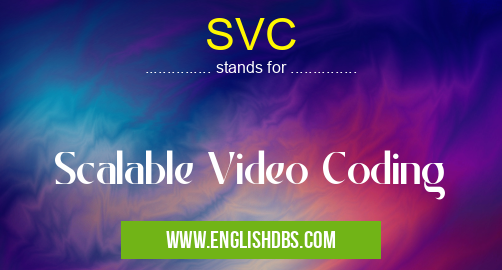What does SVC mean in COMPUTING
SVC stands for Scalable Video Coding. It is a type of video coding that is used to make videos compatible with different types of devices. This technology ensures that the video being streamed or downloaded is at its best quality and resolution regardless of the device it is being viewed on. SVC is advantageous for streaming service providers as they don’t have to worry about formatting their videos for various devices.

SVC meaning in Computing in Computing
SVC mostly used in an acronym Computing in Category Computing that means Scalable Video Coding
Shorthand: SVC,
Full Form: Scalable Video Coding
For more information of "Scalable Video Coding", see the section below.
Advantages Of SVC
The main advantage of using SVC over traditional video coding methods is that it enables streaming service providers to save time and infrastructure costs by encoding videos only once instead of multiple times for different devices and platforms. Additionally, since users get better resolution even on low-bandwidth connections there are fewer chances of interruptions due to slow-loading times or buffering issues. This leads to an overall improvement in user experience while viewing online content with no compromise in quality.
Essential Questions and Answers on Scalable Video Coding in "COMPUTING»COMPUTING"
What is Scalable Video Coding (SVC)?
Scalable Video Coding (SVC) is a video coding standard that allows users to tailor a video stream according to their needs. SVC is based on the H.264/AVC video compression standard, and provides superior visual quality and compression performance. Using SVC, a single encoded bitstream can be transformed into multiple resolution- or quality-scalable bitstreams that are decoded by receiving devices with different capabilities.
What are the benefits of using SVC?
The primary benefit of using SVC is its scalability – it enables users to exchange videos with greater efficiency due to its high compression rate and better image quality than other standards. Additionally, SVC supports low-latency streaming in conjunction with adaptive streaming protocols for an improved user experience.
How does SVC work?
SVC works by allowing encoders to create multiple versions of the same data stream at different resolutions and qualities at the same time. These streams can then be transmitted separately, enabling different receivers to receive only the stream best suited for their device's capabilities, or combined together to form a single seamless quality improvement transmission.
What technology does SVC rely on?
SVC relies on technologies such as motion estimation, temporal prediction, spatial prediction, intraframe encoding, interframe encoding, and scalable entropy coding in order to compress videos and create multiple lower resolution versions of each frame while maintaining a consistent level of quality between them.
Who developed the SVC standard?
The Scalable Video Coding (SVC) standard was jointly developed by MPEG (Moving Picture Experts Group) and VCEG (Video Coding Experts Group).
What are some applications of SVC?
SVC has numerous applications including live broadcasting and streaming media services like Netflix or YouTube; interactive gaming; virtual reality (VR); augmented reality (AR); multi-viewer support; network digital video recorder systems; surveillance systems; medical imaging systems; and immersive multimedia content delivery applications such as 360° panoramic videos.
Does SVC require specialized hardware or software?
No, neither specialized hardware nor software is required for decoding or encoding an SVC bitstream - any device capable of accessing an H.264/AVC codec can decode an SVC bitstream with minimal modifications. However, additional computing power may be required for advanced features such as spatial scalability or fast motion estimation algorithms.
How efficient is the scalability provided by SVC?
The scalability provided by Scalable Video Coding (SVH) is very efficient – it allows receivers to choose either higher resolution streams with better visual quality or lower resolution streams which require less bandwidth without sacrificing too much visual fidelity.
: Are there any alternatives to SVH?
: Yes, alternative solutions such as layered coding approaches can also provide similar levels of scalability but may not provide the same level of efficiency offered by SVH.
Final Words:
In summary, SVC stands for Scalable Video Coding which enables encoding videos once while allowing smooth streaming irrespective of the device being used or the resolution available on it. This makes streaming easier than ever before by enabling lower bandwidth requirements without any decrease in visual quality ensuring maximum user satisfaction with minimal delays in buffering or latency issues due to slower connections speeds.
SVC also stands for: |
|
| All stands for SVC |
